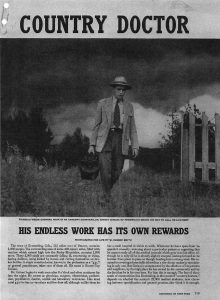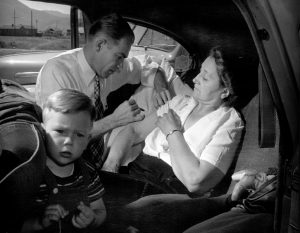An “out-take” from the “cutting room floor”
LIFE MAGAZINE
Rural health care, far away from cities is hard to come by. But the dedication of a country doctor may have saved my grandmother’s life.
My parents and their first child, Paul, age two, joined my grandparents and dad’s brother for a road trip to the America’s West in 1948. I couldn’t include details of this trip in my upcoming book without going off-topic. Instead, I include it here. It’s about a happenstance event that placed them smack in the middle of a famous Life Magazine photo essay.
MY GRANDMOTHER’S RACING HEART

Life Magazine’s opening page to “The Country Doctor.” Photos by W. Eugene Smith.
My grandmother had a cardiac condition called tachycardia. As the family drove into the mountains, her heart began racing. Somehow they got in touch with the local country doctor for help.
It just so happened that one of America’s most renowned photographers, W. Eugene Smith, was following this Dr. Ceriani around, photographing his endless days and varied patients. Ceriani was truly a “doctor of all trades.” He delivered babies, set broken bones, sewed up lacerations. Once he worked in vain to save a toddler’s eye after an accident. He even came to the aid of a sixty-one-year-old woman traveling with her family.

W. Eugene Smith photo of my Grandma Gartz and my brother, 2-year-old Paul for “The Country Doctor” in Life Magazine
THE COUNTRY DOCTOR – NOW FOR THE AGES
Smith’s photos were gathered into an iconic photo essay, “The Country Doctor,” published in Life Magazine, 1948. It included the photo Smith took of Dr. Ernest Ceriani giving a shot to my grandmother to calm her pounding heart. Grandma and Dr. Ceriani are seated in the car’s back seat. Two-year-old Paul is in the foreground. In the distance, seen through the car window, are rising mountains, defining the location.
My Grandma Gartz, watches the needle go into her arm with her trademark stoicism; the doctor’s face and eyes are concentrated on administering the injection. Paul stares past the camera, looking perplexed, worried, or both.
WHERE’S THE PROOF FOR THAT FAMILY STORY?
My parents often told me about this chance incident on their travels West. Digging through the archives, I found their saved copy of the entire Life Magazine issue, tracked down the W. Eugene Smith archives, and ordered three copies from the original negative, one for each brother and me. I gave one to Paul as a birthday present and framed my copy which now hangs on my family history photo wall.
It’s a reminder of how serendipity can enter our lives at any time, especially if you put yourself out there in the world. My family had a small part in the creation of a famous series of photographs that showed in stark and intimate detail the work of an unsung hero and the genius of a photographic artist.
UNSUNG HEROES
How many thousands of unsung heroes are out there? If you know of one, please share in the comments.
To find out more about W. Eugene Smith, start here to learn about him and here to see more images.
Addendum:
RURAL MATERNAL HEATH CARE DISAPPEARING

For information about this map, please see the article. It’s too detailed for this post.
About a week before this post was scheduled to go live, an article from ProPublica popped up in my newsfeed. It’s a reminder of just how critical Dr. Ceriani’s services were for rural people–and how a critical shortage of medical care today endangers the lives of mothers and babies: “Another Thing Disappearing from Rural America: Maternal Care.”
WHAT’S YOUR STORY OF MOMS GIVING BIRTH?
Do you know someone who died or nearly died in childbirth? Please tell us your story. If you want to reach out to us directly, email us at Maternal@propublica.org.”
The days when a single country doctor could provide every type of health care, including emergencies, are long gone. We need government funding to save the lives and health, both physical and mental, of all Americans, moms, and future citizens.
SHARE YOUR STORY
Please share how you feel about unsung heroes, like Dr. Ceriani, or about the danger of having no services to replace the kind of dedication he showed 70 years ago?
terrific story, accompanied by unforgettable pictures!